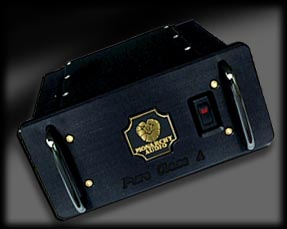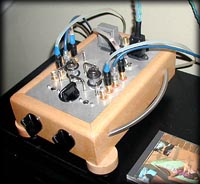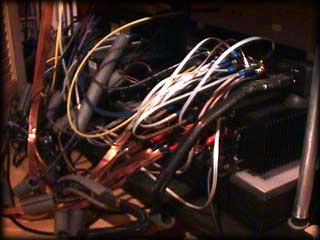
Origins of AudioVideoPhilia
Urk. How did this happen?
I bought my first stereo in 1977: Sony receiver, Kenwood turntable, Yamaha NS5 speakers. By the time I graduated from college it was: NAD integrated amp, Harmon-Kardon tuner, Philips turntable, EPI and Yamaha speakers. Eventually the Philips TT died and was replaced with a Sony. Somewhere in the late 80's I replaced the Yamahas with a pair of Polk Monitor 5 speakers.
In 1990 I got lazy about getting up to adjust the volume and wanted a remote control, so I bought a Yamaha receiver and my first CD player. Then I got the bright idea to hook up my 1985 Mitsubishi 19 inch TV and Pioneer LDV4200 laserdisc player to my stereo. Man, I had it all!
In 1997 DVD hit big. The Pioneer Laserdisc player was getting a little long in the tooth. And it did not have a flip function, so I had to get up and turn over the disc to view side two (a Laserdisc could only hold about 45 minutes of video per side)... and I'm lazy, remember? So I set my sights on the brand new Pioneer DVL700 combo player with Laserdisc and DVD.
That was the last thing I recall before the blur...
Where did I go wrong? Well, reading too much on the web. You get sucked into it and soon, so soon, it begins to sound reasonable and you're dreaming of bi-amping those speakers and tweaking your room. Be afraid.
In this page:
The 1998 system

- Parasound HCA-806 Amplifier (6 channels)
- Angstrom 100 Preamp/Processor
- Acurus ACD11 CD Transport
- Pioneer DVL700 LD/DVD Player
- Panasonic S-VHS VCR
- Onkyo Tuner
- B&W P5 Main Speakers
- B&W HTM Center Channel Speaker
- Velodyne Subwoofer
- Mitsubishi 31 inch TV
- Sandbox Isolation System
- Custom Speaker Stands
- Custom Video Stand
As it was: All the stuff described beside the pictures above, plus a few power conditioners, and an 80 watt Harmon-Kardon model 22 power amp beside the couch to drive the Optimus/Lineaum LX5 surround speakers (not much bass, but the dipole film tweeters are just about perfect). So the Parasound amp had all six channels free to bi-amp the front three speakers. Woooo.
You see, in the 1990s the problem was what to do if you wanted great sound for movies AND music. Tough choices.
The last major purchase on Godzilla was the Angstrom preamp/processor in September 1998, and I had nothing but great things to say about the amazing sound of this design. The DACs were wondrous for the price. It made the on-board DAC in my Acurus CD player sound tinny and cheap. The air, the ease, the detail. I'm gushing.
Unfortunately, the first one I had died after nine months, and by that time Angstrom had closed shop (10 year warranty?). The shop where I bought the thing was very accommodating and swapped my broken fuzzmaker for their floor sample, since they were not going to be selling anymore of them anyway. After another eight months, this one failed the same way as the first (hrm, a pattern here?). I thought that the ideas in the design were accurate, that there was a market for a good-sounding purpose-built $1000 AV preamp; but I must have been wrong.
And software. Ya gotta have software. By this point I was carrying around 300 CDs, 60+ DVDs, another 60+ Laserdiscs. And a jones for more. Bring on some Holly Cole and Diana Krall. (We have seen them both in concert in Atlanta at a smaller venue, Blithe says they "sound better at home").
Blithe was sold on the sound, and even let me put it Godzilla in it's rightful place of worship in the living room. She even got me a Marantz RC2000 remote for Christmas 1998 to replace the five remotes on the ottoman.
1999 - Never enough
In July of 1999 we bought a house in Morningside, a midtown Atlanta neighborhood. The good news for my Audio Jones was that the house had a basement bedroom that was perfect for a small home theater. The bad news, besides the financial impact of renovating an old house, was that Blithe didn't want that to be the main system, as she rightfully feared she would never see me again...
There was now a separate living room to consider. Yup, definitely time to put together a 'music only' system.
 So I broke up Godzilla, and installed some of it in the enclosed porch for TV watching
(the TV, LD/DVD player, VCR, and the LX5 surrounds, along with a new 'little' Denon 1600 I found on sale and my old old old Polk Monitor 5 speakers for mains).
It fights for attention with our new reef tank, but manages to hold it's own.
So I broke up Godzilla, and installed some of it in the enclosed porch for TV watching
(the TV, LD/DVD player, VCR, and the LX5 surrounds, along with a new 'little' Denon 1600 I found on sale and my old old old Polk Monitor 5 speakers for mains).
It fights for attention with our new reef tank, but manages to hold it's own.
 The living room got the CD player, Angstrom preamp, and the tuner.
Which came up a little short of a complete system.
I'm off to the web in search of some good sounding speakers and amps.
Eventually I made a deal for a pair of Monarchy Audio SM70 amps, along with a pair of JMlabs Daline 6.1 speakers.
The amps are wonderful, very small and heavy single-ended MOSFET units that put out 25 watts per channel,
or can be switched to 70 watt monoblocks. Zero negative feedback used.
For more info, here is a review of 'em on Soundstage.
The living room got the CD player, Angstrom preamp, and the tuner.
Which came up a little short of a complete system.
I'm off to the web in search of some good sounding speakers and amps.
Eventually I made a deal for a pair of Monarchy Audio SM70 amps, along with a pair of JMlabs Daline 6.1 speakers.
The amps are wonderful, very small and heavy single-ended MOSFET units that put out 25 watts per channel,
or can be switched to 70 watt monoblocks. Zero negative feedback used.
For more info, here is a review of 'em on Soundstage.
 The new JMLabs Daline speakers are very efficient at 92dB/watt and a pretty easy amplifier load.
They use a Transmission Line design, which acts sort of like a horn at bass frequencies.
The drivers are in a D'Appolito array in tall narrow enclosures. Great sound!
Sadly, like everything on this page, no longer made.
The new JMLabs Daline speakers are very efficient at 92dB/watt and a pretty easy amplifier load.
They use a Transmission Line design, which acts sort of like a horn at bass frequencies.
The drivers are in a D'Appolito array in tall narrow enclosures. Great sound!
Sadly, like everything on this page, no longer made.
 I still needed a replacement preamp for the Angstrom so I could get the basement video system working.
It sounded pretty good in the living room, but there was definitely no need for the Dolby Digital
decoding, and it had weird inputs for an analog-only system.
I started looking for a bargain 'audiphile approved' preamp, and fell into a black hole of DIY tube junkies.
I still needed a replacement preamp for the Angstrom so I could get the basement video system working.
It sounded pretty good in the living room, but there was definitely no need for the Dolby Digital
decoding, and it had weird inputs for an analog-only system.
I started looking for a bargain 'audiphile approved' preamp, and fell into a black hole of DIY tube junkies.
Yes, I built a tube preamp from a kit with a lotta mods, and it sounds pretty amazing when I'm not taking it apart and upgrading stuff. Since it's a long story, it gets a separate page.
Oh, and here's the link to the vendor, if you are comfortable working with a soldering iron and high voltages: www.bottlehead.com home of Electronic Tonalities
I also had about 150 albums left on the shelf, and no turntable. According to the web audio world I needed a Rega, a decent cartridge, and a phono preamp to get the signal up to line level so I could input it into my main system.
I ended up with a used Pro*Ject 6.1 Turntable with a Grado Platinum cartridge and a Musical Surroundings phono amp. I'm still fiddling with this setup to get better sound. I basically had to rebuild the TT, which is a pretty tweakable model anyway (called 'a poor man's Gyro' somewhere online...).
The bearings on the tonearm were out of adjustment and I had to order a replacement anti-skating weight lost by the previous owner. Like Linn TTs the Pro*Ject has a tricky spring-suspended sub-chassis which requires care to set up and was sensitive to weight changes. I like dinking around with mechanicals anyway. I was happy with the Pro*Ject for two years and it lasted through a series of tweaks before I replaced it with a 1962 Empire 208.
With the tube preamp and turntable I eventually had to build a tube phono amp, and happily Doc Bottlehead asked me to be a beta tester for their new Seduction Phono Amp, so good it played in various systems for fifteen years.
2004 Audio-only System
In Fall 2002 we were (I was) transferred to Charlotte, NC.
Urk, this stuff is heavy to move. Twice. We first moved into a rental house in Charlotte while we decided what to do with the house in Atlanta - finally sold the house in Morningside and bought an equivalent house in Charlotte. Woo. Moved into our new Charlotte house in February 2004.
- Empire 208 Turntable (with Rega RB250 tonearm and Grado Sonata cartridge)
- Bottlehead Seduction phonostage
- Scott 330-C tube AM/FM tuner
- Sony C333ES SACD changer
- Mambo 6H30pi DIY preamp (the second DIY tube preamp used Russian tubes)
- il Monstro 845:845 power amps (DIY tube amplifier I was designing and building from 2001-2003 that uses giant thoriated tungsten movie-theater amp tubes)
- Adire HE12.1 speakers (DIY speakers based on 12 inch coaxial PA speakers)
2002-2007 Home Theater System
A Denon DVD-2900 was a birthday gift (thanks, Blithe!) and has very very very fine video decoding - extremely close to the HDTV output from a new Time-Warner cable box. There was no way to go back to the Pioneer combo-player for DVDs aftre seeing the Denon picture.
- Mitsubishi 46805 Digital Widescreen RPTV (rear-projection 1080p, 3 separate tubes for R, G, B)
- Denon DVD-2900 DVD/SACD/CD Player
- Pioneer DVL-919 Combo DVD/Laserdisc/CD Player (only used for LD since the Denon was a much better DVD player)
- B&K Reference 20 Preamp
- Parasound 806 6-channel amplifier driving five speakers
- B&W P5 Main Speakers
- B&W HTM Center Channel Speaker
- Optimus Pro LX5 Rear Speakers with upgraded woofers and CAT5e 18ga cables
- Velodyne Subwoofer
- Monster Interconnect Cables, Goertz Speaker Cables, Handmade F-pin Cables
- Monster HTS-2000 Power Conditioner
Cables?
Some people say you cannot hear cables... Hmm.
I've heard a bunch of cables in my system, and they all sounded different.
I'm currently running about $3k worth of Alpha-Core Goertz flat cables from a barter deal (silver interconnects and copper speaker cables). I rebuilt their entire website and they gave me enough cables for Godzilla. The difference was startling. Bigger, more controlled bass, extended treble, better detail. These are great cables, and the copper versions are actually pretty inexpensive.
I've also tried a few different digital cables - you would think that a digital signal would not be affected much, yup, you can still hear the difference.
When I fell off the earth into the DIY alternate reality I finally realized that I was only band-aiding my system by switching cables - not that there is anything wrong with that - but changing an output capacitor makes an even bigger differnce than any cable. In the last couple of years I have built a lot of cables for the 'listening' system and have been perfectly happy with the sound of simple CAT5e twisted pair interconnects. Live and learn.
 Cables, cables, cables
Cables, cables, cables
Goertz MI2 Bi-amp Speaker Cables
Goertz Sapphire Silver Interconnects
DH Labs Silver-Sonic Interconnects
Illuminations Digital Interconnect
Cardas Digital Interconnect
XLO S-Video Cables
Tributaries F-Video Cables
Monster Composite Video Cables
Foam Insulation
Tweaks
This is where you should probably stop reading.
No, really, stop now unless you are as sick as I am.
OK, here are some of the voodoo tweaky audiophile things I've done so far:
Rearrange the room
Try this first. Move the speakers about 1/3 of the way into the room and place them about 1/3 of the room width apart. Now get a good CD and make sure no one can see you. Get some tape and mark the floor where the speakers start out as a reference, and then start playing music, then hop up and move the speakers a little (forward, back, toe-in, straight), listen some more, hop up and move them, etc, until you're sick of it. Ah, sounds better already.
I do still have the main couch/listening position against the wall, but what can I do? Blithe says I have to be a little bit practical sometimes. Hey, I did let her put a wood cat sculpture on one of the speakers. It's kinda cute.
Custom Speaker Stands
I wasn't happy with the height of the tweeters on the P5 mains, I thought they were a little low. So I went down to Home Depot and bought eight 12 inch square concrete pavers to stack up under the speakers. I added and removed pavers to find the correct height over a few weeks. Then I designed and made some solid cherry stands with adjustable spikes, and bolted them to the speaker base via the P5 spike sockets with a piece of sorbothane dampening sheet between the stand and speaker. The gel panel damped vibration at the bottom of the speaker cabinet, which you can hear when you rap on different places with your knuckles. They went 'klunk' when I got near the bottom, and the bass notes sounded a little tighter.
All things change, and with the new AV room for the home theater system the speakers were too high with the custom stands with the center channel relocated below the screen of the new TV. So I removed the cherry stands and added a piece of strap iron across the bottom front to get the spikes out to a more stable position. With listening I ended up with the speakers tilted slightly back, and the side-to-side pan effects now blend well again with the HTM center channel.
Build some Sandboxes
These are really tweaky. So tweaky, they have a page too.
Foam Cable Spacers
I cannot be stopped. Another trip to Home Depot for foam water pipe insulation and a pair of scissors, and I'm ready to go. I cut sections of insulation and wrapped them around the places where AC cords, signal interconnects, and video cables crossed.
Put Ferrite Clamps on the Power Cables
All those digital devices create high frequency hash that is picked up by all those cables running all over the back of the system. This noise is also carried out via the AC lines (and in from the power grid). So I've added ferrite clamps (iron/ceramic tubes that filter high-frequency noise) to all of the power cords and most of the signal and data lines. They can also be ganged up with multiple clamps per line, but go slow and listen as you add them; you don't want to remove any of the music, just the grunge from the sound.
Do a Ground Loop Check
Get an electrical multimeter and check the potential between your components. Any current flowing is bad grounding, and it happens very easily in a home theater setup with mixed audio and video electronics. This current, or ground leakage, makes grundgy noise you can hear. Another trip to Home Depot for some copper cable and a replacement grounded plug, and I made a pigtail (multiple strands with spades on the end which are bolted onto the ground pin of the plug). I tried several connections, removing chassis screws to attach the leads, before I found the quietest configuration where current leakeage was reduced to almost nothing.
Center Speaker Isolation
The B&W HTM sits on top of the Mitsubishi rear-projection TV square cabinet. Without adjustment the tweeter points about 3 feet over your ears when seated. I had some sorbothane gel left over from recovering my motorcycle seat, so I put some between the TV and the back edge of the HTM to point it downwards. This worked great, damping vibration from the room and speaker while making the side-to-side effects panning much cleaner.
But the sorbothane also reacted badly with the finish on the TV and I now had two melted spots under the speaker.
Do as I say, not as I do. Put something (I now have rubber coasters under the gel) between the any weird, sticky, tweaky substance and a nice finish.
A better-sounding approach was to put the center speaker on a stand in front of the TV and adjust the alignment in the Dolby decoding. But sometimes there isn't room.



